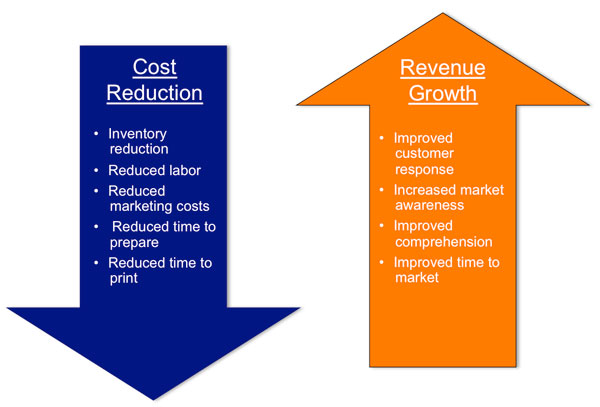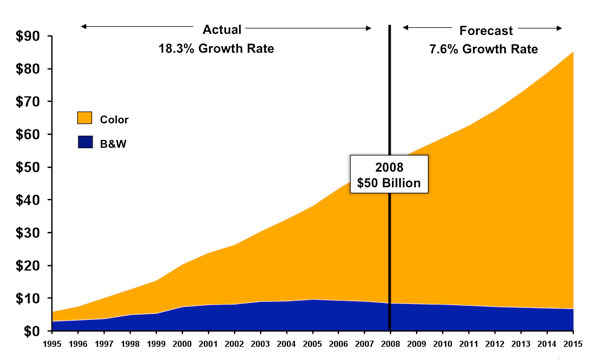It should come as no surprise that the economy is the number one issue on everyone’s mind. Most people know a family member, friend, or business associate that has been impacted by the job cuts taking place in today’s market, and some people have been affected personally. During this year’s ON DEMAND event in Philadelphia, Charlie Pesko of InfoTrends delivered a keynote address that discussed the current economic realities of the printing industry. Rather than focusing on the doom and gloom of a difficult economy, however, Charlie discussed business initiatives that can help print service providers weather the storm and emerge from this recession even stronger.
Market Realities for the Printing Industry
Pesko opened his keynote by discussing market consolidation. From a statistical perspective, the nation’s overall unemployment rate ended 2008 at 7.2%, representing a 16-year high. Additionally, some economists believe that unemployment may reach 10% by the end of this year.
Printers are no exception to today’s economic woes—total employment in printing and related support activities fell 3.7% in 2008 to 601,000. This is the steepest drop since 2003.What’s more, available data shows that total employment in the commercial printing industry was down 3.3% during the first 11 months of 2008, averaging almost 462,000 for the period. Furthermore, job losses in commercial print are intensifying—November 2008 employment was down 6.5% from the previous year. Over the past decade, the number of actual commercial printing establishments has fallen by 24% — to put this another way, we have lost 6,900 printers.
A Winning Strategy in a Recession
The messages that initially resonated with on demand technology—just-in-time, on demand, and zero inventory—are critical in a difficult economy. They are essential to the overall cost reduction picture, and Web-enabled strategic sourcing is the answer.
Throughout 2009, Pesko believes that there are two key trends to watch:
- Digital Effectiveness: Effectiveness means “doing the right thing”—conducting the right activities and applying the best strategies for competitive advantage. Effectiveness says that you have invested in the right technologies to reduce document inventory/obsolescence and deliver ROI-driven marketing communications solutions. Savvy print service providers must understand how to make money delivering finished print products and monetize non-print revenue streams (e-mail, personalized URLs, Web landing page creation, and campaign management strategies).
- Digital Efficiency: Efficiency is “doing the thing right”—meaning that processes are completed using the least resources and in the shortest time possible. Graphic communications providers must focus on integrating workflow starting with Internet-driven customer-facing order entry capabilities and JDF workflow that automates the interfaces with MIS and production.
Back to the Basics for Print on Demand!
Pesko noted that when InfoTrends conducted its first ON DEMAND conference in 1992, the message was that print on demand delivered what was needed, when it was needed, and in the exact quantity required. It offered quick turnaround while eliminating waste and reducing obsolescence. It was a zero inventory approach to print production that saved businesses money. Print on demand also helps organizations grow their revenue with increased response rates, better impact, and improved time to market. Although the industry has changed a lot, Pesko believes that it’s time to go back to the basics with the same messages that have been around since 1992.
Figure 1: Basic Principles for Print on Demand

The Retail Value of Print
The U.S. print on demand market experienced an 18.3% growth rate between 1995 and 2008, reaching a value of $50 billion at the end of last year. Retail sales within the print on demand market have proven to be fairly recession-proof—Pesko expects the growth in this market to continue through 2015, albeit at a slower rate (7.6%). By 2015, retail sales within the print on demand industry are expected to hit $85 billion.
Figure 2: U.S. Print on Demand Market – 1995-2015 ($Billions)

Investing in the Right Application Solutions
While the technology is readily available, success in today’s market will be directly linked to the ability to utilize this technology to deliver value-added solutions for customers and streamline work processes. Charlie Pesko covered five application solutions that can help ensure success in a difficult economy.
Web-to-Print
Corporate print buyers are reporting increased efficiencies as a result of Web-to-print services. Based on InfoTrends’ research, print buyers reported an average savings of over 14% as a result of implementing Web-to-print services. They also achieved the added benefits of reduced turnaround times, improved tracking, fewer errors, and better corporate brand management—all critical factors in economically challenging times.
Multi-Channel Communications
It is estimated that today’s consumers spend 25% to 30% of their total media time multi-tasking. In addition, the more media that a person consumes, the more likely it is that they will consume several channels at once. Perhaps most importantly, consumers that use at least three channels when shopping spend up to ten times more than single-channel consumers and generate 25% to 50% more profit!
Lean Manufacturing
Pesko believes that many printers, particularly smaller ones, are struggling to reconcile two critical needs that are equally important to their long term prosperity:
- The need to offer customers continually improving and innovative services
- The need to increase the efficiencies of their underlying manufacturing operations
Today’s print providers must find a way to offer real-time communication and Web-enabled links between suppliers, production processes, customers, and business processes. Failure to make these workflow investments today may make it difficult for you to compete in the future.
TransPromo Documents
Pesko noted that the buzz surrounding TransPromo continues, and this concept is even more important in a tough economy. Transactions are linked to agreements between two parties related to the exchange of goods and services. While the initial focus of TransPromo was on the promotional portion (cross-selling to existing clients), today’s companies are now leveraging this touchpoint to educate, inform, and promote. Simply stated, the term TransPromo refers to a transaction document that consists of a promotional message that is positioned alongside essential transactional information. TransPromo converts trusted documents that are simply conveying information into documents that inform, promote, and interact with recipients. It blends the opportunity educate and sell offered by promotional documents, with the collection and summarization of data inherent in transactional documents to deliver a new communications model that informs and interacts with the recipient.
Photo Publishing
In uncertain economic times, the photo publishing market—which includes photo books, photo calendars, photo cards, and specialty prints—represents a somewhat recession-proof segment. In fact, the photo publishing market grew by 38% during 2008. The photo publishing market will break the $1 billion barrier in 2009, and this amount is expected to reach $2.5 billion by 2013 (22% CAGR from 2008-2013).
Marketing Your Company during a Recession
In a down economy, businesses must pay special attention to their marketing strategies, and service providers must find a way to differentiate themselves. As a matter of fact, brands that increase advertising during a recession when their competitors are cutting back can improve their market share and return on investment at a lower cost than in good economic times.
During a recession, elasticity spikes because people are willing to switch or stop consuming due to small changes in price. Marketing can help combat these effects by reminding customers and prospects about the value you deliver. Effective strategies include:
- Ensuring that you are monitoring client relationships with a good CRM tool
- Demonstrating ROI-oriented solutions through your own campaigns
- Conducting seminars for clients on cost-effective marketing or getting document inventory under control
- Working with the press to highlight your successes
- Blogging
- Demonstrating your capabilities through printed specialty and promotional items
Investing in Your People
In today’s market, graphic communications firms must understand that there is a technology shift in which hiring needs to focus on knowledge workers versus production-oriented workers. The reality is that attracting talent to a perceived “non-glamour” industry like printing can be difficult.
Pesko revealed the five best practices that successful firms are using to meet the demands of a digital world:
- Positioning your firm to attract the right talent
- Clearly defining essential skills and building job descriptions
- Developing a combined “build versus buy” talent pool
- Developing a structured, proactive recruiting process that includes testing
- Embracing ongoing education
Conclusion
Pesko summed up his speech by stating, “Surviving in today’s economy means going back to the basics and incorporating strategies that will help make and save money.” This involves:
- Printing what is needed, when it is needed and in the exact quantity required to reduce waste and inventory obsolescence
- Delivering more relevant messaging
- Maximizing operational efficiency and being the most cost-effective provider
- Optimizing resource utilization
- Delivering ROI for your business and your customers
In 2009, the name of the game is digital effectiveness and efficiency—so do the right thing and do the thing right!














